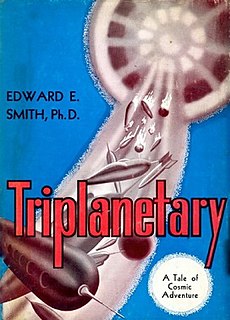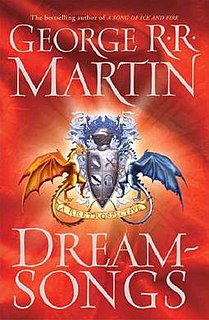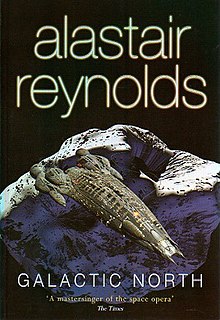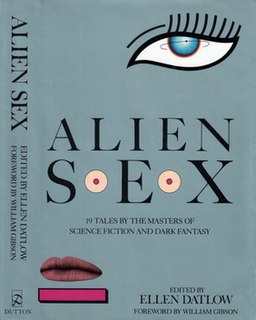Related Research Articles

Paul J. McAuley is a British botanist and science fiction author. A biologist by training, McAuley writes mostly hard science fiction. His novels dealing with themes such as biotechnology, alternative history/alternative reality, and space travel.
The Galactic Empire series is a science fiction sequence of three of Isaac Asimov's earliest novels, and extended by one short story. They are connected by their early place in his published works and chronological placement within his overarching Foundation universe, set around the rise of Asimov's Galactic Empire, between the Robot and Foundation series to which they were linked in Asimov's later novels.

Alastair Preston Reynolds is a British science fiction author. He specialises in hard science fiction and space opera. He spent his early years in Cornwall, moved back to Wales before going to Newcastle University, where he read physics and astronomy. Afterwards, he earned a PhD in astrophysics from the University of St Andrews. In 1991, he moved to Noordwijk in the Netherlands where he met his wife Josette. There, he worked for the European Space Research and Technology Centre until 2004 when he left to pursue writing full-time. He returned to Wales in 2008 and lives near Cardiff.

Gardner Raymond Dozois was an American science fiction author and editor. He was the founding editor of The Year's Best Science Fiction anthologies (1984–2018) and was editor of Asimov's Science Fiction magazine (1984–2004), garnering multiple Hugo and Locus Awards for those works almost every year. He also won the Nebula Award for Best Short Story twice. He was inducted to the Science Fiction Hall of Fame on June 25, 2011.

The Lensman series is a series of science fiction novels by American author Edward Elmer "Doc" Smith. It was a runner-up for the 1966 Hugo award for Best All-Time Series.

Absolution Gap is a 2003 science fiction novel written by Welsh author Alastair Reynolds. It takes place in the Revelation Space universe and is a direct sequel to Redemption Ark.

The City and the Stars is a science fiction novel by British writer Arthur C. Clarke, published in 1956. This novel is a complete rewrite of his earlier Against the Fall of Night, Clarke's first novel, which had been published in Startling Stories magazine in 1948 after John W. Campbell, Jr., editor of Astounding Science-Fiction, had rejected it, according to Clarke.

Redemption Ark is a 2002 science fiction novel by Welsh author Alastair Reynolds set in the Revelation Space universe. It continues the story of Nevil Clavain begun in the short stories "Great Wall of Mars" and "Glacial".

James Henry Schmitz was an American science fiction writer born in Hamburg, Germany of American parents.
"The Undiscovered" is an alternate history short story by William Sanders that won the Sidewise Award for Alternate History. "The Undiscovered" was originally published in the March 1997 issue of Asimov's and, in addition to its Sidewise Award nomination, was nominated for the Hugo Award, the Nebula Award, and the Theodore Sturgeon Award. The story was subsequently reprinted in The Year's Best Science Fiction: Fifteenth Annual Collection, The Best Alternate History Stories of the 20th Century, and Best of the Best: 20 Years of the Year's Best Science Fiction.

The Fifth Head of Cerberus is the title of both a novella and a single-volume collection of three novellas, written by American science fiction and fantasy author Gene Wolfe, both published in 1972. The novella was included in the anthology Nebula Award Stories Eight.

Dreamsongs: A Retrospective is a career-spanning collection of George R. R. Martin's short fiction. It was first published in 2003 as a single volume hardcover from Subterranean Press under the title GRRM: A Retrospective and debuted in Toronto at Torcon 3, the 63rd World Science Fiction Convention, where Martin was the Writer Guest Of Honor. The collection features 34 pieces of fiction, an introduction by Gardner Dozois, commentary by Martin on each stage of his career, a Martin bibliography, and original art for each story. Subterranean published the book in three formats: a trade hardcover, a signed, numbered, and slipcased deluxe hardcover, and a very limited, deluxe leather-bound, lettered hardcover. The Washington Post called Subterranean's single-author collection "the most ambitious volume ever to come from an American specialty press".
The planetary systems of stars other than the Sun and the Solar System are a staple element in many works of the science fiction genre.

Galactic North is a collection of science fiction short stories by British author Alastair Reynolds, published by Gollancz in 2006. It comprises most of Reynold's short stories and novellas set in the Revelation Space universe.
Tor.com is an online science fiction and fantasy magazine published by Tor Books, as well as an imprint of Tom Doherty Associates, a division of Macmillan Publishers. It publishes articles, reviews, original short fiction, re-reads and commentary on speculative fiction.
Bruce McAllister is an American author of fantasy, science fiction, poetry, and non-fiction. He is known primarily for his short fiction. Over the years his short stories have been published in the major fantasy and science fiction magazines, theme anthologies, college readers, and "year's best" anthologies, including Best American Short Stories 2007, guest-edited by Stephen King.

Hannu Rajaniemi is a Finnish American author of science fiction and fantasy, who writes in both English and Finnish. He lives in Oakland, California, and was a founding director of a commercial research organisation ThinkTank Maths.

"And I Awoke and Found Me Here on the Cold Hill's Side" is a science fiction short story by American author James Tiptree, Jr. Originally published in The Magazine of Fantasy & Science Fiction, the short story has been republished in several anthologies.
This is a bibliography of American science fiction author Kim Stanley Robinson.

Beyond the Aquila Rift is a 2016 collection of science fiction short stories and novellas by British author Alastair Reynolds, published by Gollancz, and edited by Jonathan Strahan and William Schafer. It contains works previously published in other venues. The collection features several stories connected to Reynolds's previous stories and novels. "Great Wall of Mars", "Weather", Last Log of the Lachrymosa, and Diamond Dogs take place in the Revelation Space universe, Thousandth Night takes place in the same universe as House of Suns, and "The Water Thief" takes place in the Poseidon's Children universe.
References
- ↑ One example is the "Hades matrix" in Revelation Space: a supercomputer created inside a neutron star, and capable of communicating freely with its own past and future selves.
- ↑ "Science fiction 'thrives in hi-tech world'". BBC News Online . 30 April 2007.
I prioritise story over science but not at the expense of being really stupid about it. If there's a story I absolutely cannot tell without faster than light travel then I am quite prepared to accept it — even though I don't personally believe it is possible.
- ↑ Absolution Gap , pages 412–13 in the hardcover version, although many other passages hint at it.
- ↑ From an interview with the author: "Galactic North is actually quite optimistic, in my book, because it hints that there will still be thousands of years of good times ahead before things reach a crisis point again. And humanity will survive that, as well, even if it means abandoning the old galaxy. So in a way I think the whole thing's quite cheerily upbeat!"
- ↑ Revelation Space , Chapter Four: page 98 in the paperback edition.
- ↑ "Galactic North," the short story in the book of the same name
- ↑ Reynolds, Alastair (25 July 2017). "Elysium Fire and a new title for The Prefect". Approaching Pavonis Mons. Retrieved 21 October 2017.
- ↑ "A Spy in Europa: a short story by Alastair Reynolds". Infinity Plus. 2001. Retrieved 17 January 2012.